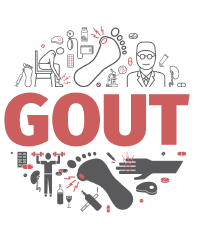
Prokopenko Oleg / shutterstock.com
A larger proportion of patients with gout had a therapeutic response at six months when treated with methotrexate and pegloticase than with pegloticase alone, according to results from the multi-center, open-label MIRROR (methotrexate to increase response rates in patients with uncontrolled gout receiving KRYSTEXXA) study, recently published in the Journal of Rheumatology.1
The MIRROR study included 14 patients with uncontrolled gout who received 15 mg weekly of oral methotrexate and 1 mg daily of folic acid starting four weeks before and continuing throughout the pegloticase treatment course.
Background
Gout affects approximately 9.2 million people in the U.S. Initial treatments with oral urate-lowering therapies are often ineffective, according to the study researchers. Some patients cannot tolerate or do not respond to these types of medications, leaving serum uric acid (sUA) levels at 6 mg/dL or higher and with continued urate deposition. Patients with persistently elevated sUA frequently have a lower quality of life and more disability.
In these patients with uncontrolled gout, pegloticase given by intravenous infusion every two weeks provides a final treatment option.
Although pegloticase is effective at lowering sUA by converting uric acid to allantoin, previous studies have shown that only 42% of patients can maintain an sUA below 6.0 mg/dL at six months of therapy. Twenty-six percent of patients also experience infusion-related reactions, thought to be due to the development of anti-drug antibodies, which also hasten pegloticase clearance and reduce efficacy.2,3 This has led some physicians to prescribe pegloticase along with immunomodulators, including methotrexate, azathioprine, leflunomide, mycophenolate and cyclosporine A, to help prevent the development of anti-drug antibodies and to lengthen the time period during which pegloticase is effective.
Studies focused on pegloticase with immunomodulators have had differing doses, routes and schedules, making it difficult to determine firm clinical recommendations. However, multiple case series have shown significant improvement with a regimen of methotrexate and pegloticase. Methotrexate and pegloticase responders were 100% in two series and 80% in another, all higher than the 42% rate seen with pegloticase alone in the previously published clinical trials, according to the MIRROR researchers.
The current study focused on the efficacy and safety of pegloticase and methotrexate used for uncontrolled gout, defined as an sUA of 6 mg/dL or higher before the study began and one or more of the following: an inability to maintain sUA of less than 6 mg/dL on other therapies, intolerance to their current urate-lowering therapy or the existence of functionally limiting tophaceous deposits.
Note: Horizon Therapeutics, the maker of pegloticase, supported the study.
Study Details
The study took place at six sites across the U.S. and included men and women between 18 and 65 years old. For four weeks before the study began, which was considered the run-in period, patients received 15 mg per week of oral methotrexate and 1 mg daily of folic acid. To determine the methotrexate dosage, study researchers used previous evidence that recommended a dose of 10 to 15 mg per week. During the treatment period, patients received oral methotrexate weekly, folic acid daily and 8 mg of intravenous pegloticase every two weeks.
One week before the study’s official start, patients began a gout flare prophylaxis regimen that included colchicine and/or non-steroidal anti-inflammatory drugs and/or low-dose prednisone (i.e., less than 10 mg/day). Patients continued the flare prophylaxis for most of the six-month period. They also received a standard infusion reaction prophylaxis of oral fexofenadine, acetaminophen and intravenous glucocorticoids.
The researchers used a pegloticase uric acid monitoring protocol to minimize the occurrence of infusion reactions.
All patients received pegloticase and methotrexate through the end of the treatment period, for up to 52 weeks, with follow-



